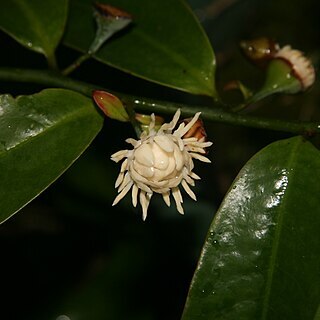Shrub with long, arching branches, or small tree to 8 m high; not known to have tubers. Stem internodes terete. Leaves: petiole 5–10 mm long, not decurrent with stem; lamina obovate, oblong or elliptic, usually 6–18 cm long, 2–7 cm wide, acuminate, glabrous; base decurrent or acute; secondary veins usually 8–11 pairs with intersecondary veins. Flowers not forming well-circumscribed inflorescences, axillary; peduncle 6–15 mm long. Floral envelope cap hemispherical or slightly apiculate, abscissing by a circumferential fissure. Stamens oblong, broadened at base, glabrous, firstly reflexed during female phase, later erect during male phase, 6–12 mm long, 1 mm wide; anthers c. 4 mm long. Staminodes oblong, 5–10 mm long, 2–3 mm wide; margins pubescent; adaxial surface with irregular patches of hairs. Aggregate fruits urceolate, 1.5–5.5 cm diam., green to very pale orange-yellow.


